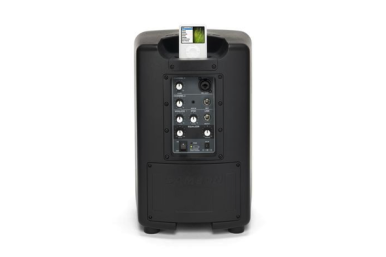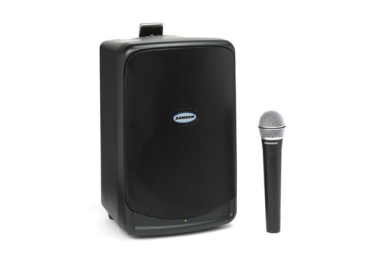Since the first dock-connector-based iPod speaker system debutedâ€"in early 2003, if I recall correctlyâ€"we’ve seen almost every type of “speaker dock†you can imagine. But audio-gear vendor Samson’s $300 Expedition XP40iw Portable PA System offers a unique take: The XP40iw is essentially a monoraul PA (public-address) speaker with a built-in iPhone and iPod dock, a wireless handheld mic, and a rechargeable battery. (Samson also sells a model without the wireless microphone, the $250 Expedition XP40i.) The system fits right into the company’s varied line of pro-audio equipment.
The XP40iw is just under 15 inches tall, 9.5 inches wide, and 9.5 inches deep and weighs a little over 18 pounds. Inside is a 1-inch tweeter, a 6-inch woofer, a gel-cell rechargeable battery, and a bunch of circuitry for the system’s myriad connections. For starters, there’s a Made-for-iPhone, Universal Dock-design dock cradle on top; conveniently, the dock faces the back of the unit so you can stand behind the system and control your music. The dock charges your iPhone or iPod even when the XP40iw is running off its own battery.
But whereas most iPhone/iPod docks offer little more than a single auxiliary-input jack, the back of the XP40iw hosts a smorgasbord of connections and knobs. There’s a combo jack (XLR and 1/4-inch) that handles microphone- or instrument-level inputs (providing phantom power); this connection gets its own level control. There’s also a 1/8-inch (3.5mm) jack for line-level input and a 1/4-inch jack for line- or instrument-level input (with the 1/4-inch jack, again, providing phantom power); this pair of inputs gets a separate level control.
Also on the rear connection panel is a 1/4-inch jack for connecting a second XP40iw or XP40iâ€"when two units are connected together, any source connected to either of the speakers also plays through the other. There’s also a level control for the iPhone/iPod dock, a level control for the wireless microphone, separate bass- and treble-level controls, a power button, a connection for the included “wall wart†power adapter, and three LEDs: one indicating the status of the XP40iw’s rechargeable battery, one indicating a connection with the wireless microphone, and the other lighting up if the level of the microphone or any source is too high and causing distortion.
Oddly, the XP40iw doesn’t offer a master volume control. This means that once you’ve matched all the levels of the various inputsâ€"the wireless microphone, your iPod or iPhone, and any additional instruments, microphones, or audio sourcesâ€"you can’t increase or lower the overall volume level with a single dial. Instead, you must adjust each level separately.
The XP40iw also hosts a 40-watt Class D amplifier. Samson says the XP40iw’s battery should last for 8 to 10 hours on a full charge. (It takes about four hours to top off the battery.) The company doesn’t note the volume level used for that claim, but based on my testing it seems like a fair estimate at moderate volume levels.
The body of the XP40iw is made of thick, polypropylene plastic with a sturdy, metal front grill protecting the speaker drivers. Although you wouldn’t want to drop the XP40iw onto concrete, it feels very solid and sturdyâ€"it should hold up to the kinds of minor bumps and blows a PA system is often subjected to. The bottom of the enclosure hosts a standard (1.4-inch) pole-stand mounting hole, so you can elevate the speaker by attaching a standard speaker pole.
The XP40iw’s enclosure also sports a handle on top for easy carrying, though if you’ve got an iPhone or iPod in the dock cradle, the handle is partially blocked. In fact, the design practically forces you to remove your iPhone or iPod before moving the unit. This is probably a good thing, since Apple’s Universal Dock design isn’t meant to hold your iPhone or iPod securely during transport.
The XP40iw’s wireless microphone is a version of Samson’s Q7 Dynamic Handheld Microphone. It’s a unidirectional model, optimized for voice, with a shock-mounted element to minimize noise and to protect the element. The system uses VHF RF (radio-frequency) technology; I tested the microphone at distances of roughly 50 feet from the speaker, and it worked well at that range, even through a couple interior walls. The mic runs off a single 9-volt battery. Samson doesn’t provide a battery-life estimate for the microphone; in my testing over a couple months of occasional use, I didn’t need to replace the battery.
Like many microphones of this type, the XP40iw’s mic uses two on/off switches. The main switch, which controls the mic’s master power, is located inside the handleâ€"you unscrew the handle and turn on the mic. (Next to this internal switch is a manual gain control; Samson recommends against changing this level unless the level control on the main unit isn’t sufficient.) On the bottom of the mic is an Audio On/Off switch. This switch must also be in the On position to transmit. However, as its name implies, placing this switch in the Off position simply mutes the mic; it remains powered on until you flip the internal switch to Off. Also on the bottom of the microphone is a three-LED battery-level meter.
My only real complaint about the XP40iw’s microphone is that the XP40iw doesn’t provide a place to store the mic when not in use. Even a simple clip on the back of the unit would be handy, especially since the mic tends to roll around on any desk or table (not to mention that if you mount the XP40iw on a stand, there’s no desk or table to put the mic on).
The XP40iw’s audio quality is very PA-like, meaning that it emphasizes the middle of the frequency range: lower treble, midrange, and upper bass. This makes the XP40iw effective at amplifying vocals, such as someone speaking or singing. On the other hand, music playback isn’t as enjoyable, as the system is missing some top-end detail, and its 6-inch woofer can’t produce the lowest bass frequencies. Still, the system works well for use in a classroom, gymnasium, or conference room, and it even plays loud enough for use at outdoor events. Only at the loudest volume levels did the XP40iw produce audible distortion, although certain bass-heavy tracks produced distortion at slightly lower volume levels, and I couldn’t increase the iPhone/iPod level much past the halfway point on bass-heavy tracksâ€"the iPhone/iPod level was “hotter†than some of the other inputs.
If you’re looking for the best-sounding iPod or iPhone dock, the XP40iw isn’t it. What it is is a versatile system that combines a rugged iPhone/iPod speaker system, a wireless PA system, and a basic mixing board with multiple inputs, and you can tote it just about anywhere. It would be ideal for a school or similar organization, for giving presentations in large rooms, or for outings to the park. It would also make a fun, easy-to-use karaoke system: If you’ve got no-vocals versions of songs, you can play those using your iPod, iPhone, or other audio source and sing along using the microphone. And thanks to its instrument-level inputs, you can even use the XP40iw as a guitar or keyboard amp. Though its sound quality isn’t stellar, we haven’t seen anything else like it.
[Dan Frakes (@danfrakes) is a senior editor at Macworld.]


No comments:
Post a Comment